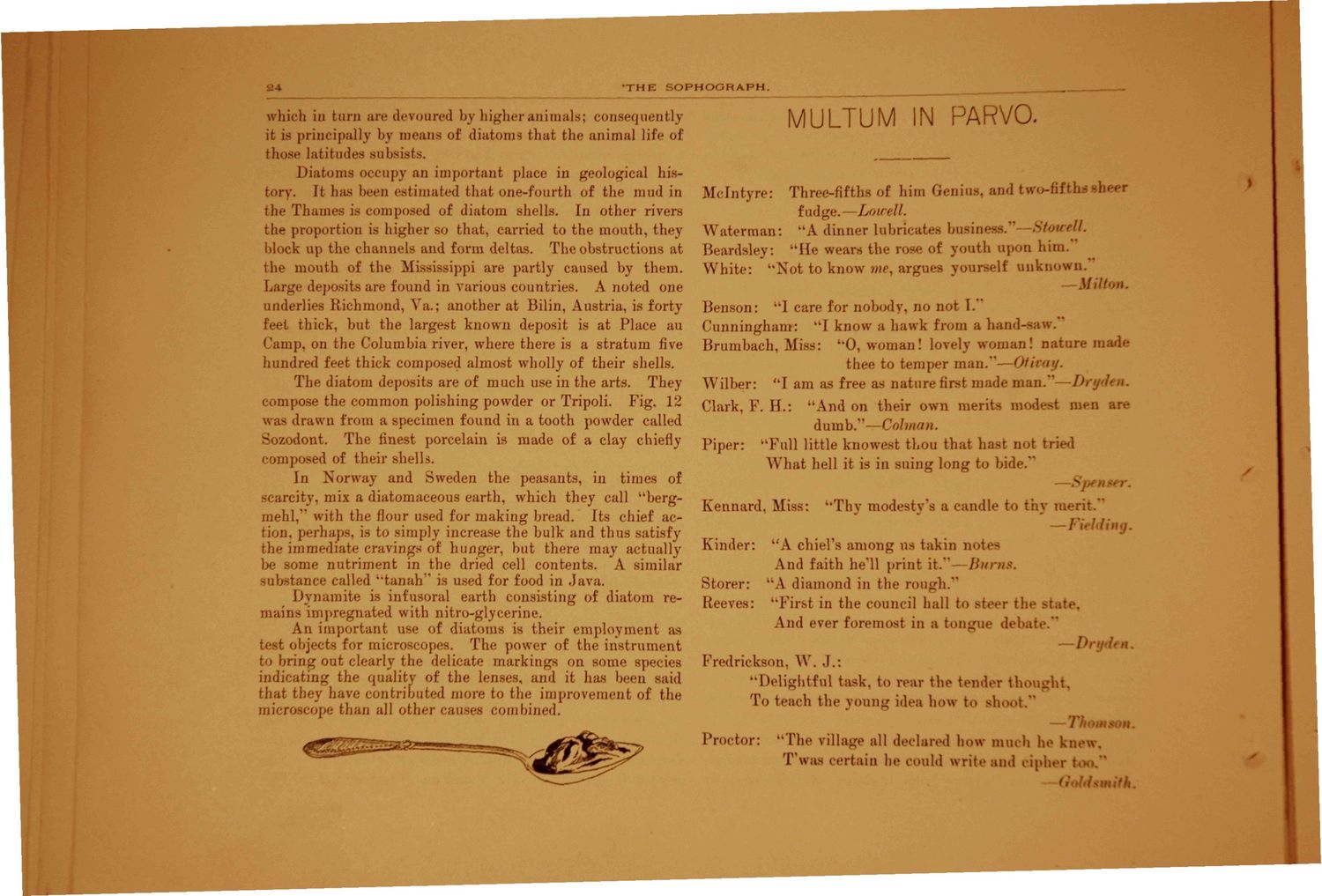| |
| |
Caption: Sophograph - 1890
This is a reduced-resolution page image for fast online browsing.

EXTRACTED TEXT FROM PAGE:
•TH1 SOI'M' HAI'M. which in turn are devoured by higher animals; consequently it is principally by moans of diatoms that fche animal life of those latitudes subsists. Diatoms occupy an important place in geological history. It has been estimated that one-fourth of tin* mud in the Thames is composed of diatom shells. In other rivers the proportion is higher so that, carried to the mouth, they block up thi bannels and form deltas. The obstructions at lie mouth of the Mississippi are partly caused by them. Lai deposits are found in various countries. A noted one underlies Richmond, Va.: another at Bilin, Austria, is forty thick, but the largest known deposit is at Place au ''amp. on the Columbia river, where tliere is a stratum five hundred feet thick composed almost wholly of their shells. The diatom deposits are of much use in the arts. They oni] the common polishing powder or Tripoli. Fig. 12 was drawn from a specimen found in a tooth powder called Sozodont. The finest porcelain is made of a clay chiefly imposed of their shells. In Norway and Sweden the peasants, in times of ircity. mix a diatomaceous earth, which they call "bergijiehl." with the Hour used \<>v making bread. Its chief acion, perhaps, is to simply increase the bulk and thus satisfy immediate cravings of hunger, but there may actually be »me nutriment in the dried cell contents. A similar [instance called "tanah" is used for food in Java. Dynamite fa infusoral earth consisting of diatom remains impregnated with nitro~glycerine. An important use <,f diatoms is their employment as t objects for micro 'pes. The power of the instrument . bring out clearly the delicate markings on some species indicating the quality of the lenses, and it has been said that they have contributed more to the improvement of the microscope than all other Cau8es combined. MULTUM IN PARVO. Mclntyre: Three-fifths of him Gteniai md two-fifth fudge.—Lowell. Waterman: "A dinner lubricat. busine/. Beanlsley: "He wears the rose of youth upon him. White: "Not to know //" . argues yom if unknown. — MilU Benson: *T care for nobody, no n I. Cunninghams 'T know a hawk from a hand-saw. Brumbach, Mi^s: "O. woman! lovely woman! n; mad thee to temper man."—Oti Wilber: "1 am as free a- nature first made man." I> Clark. V. II.: "And on their own merit> mod are dumb."- Column. Piper: "Full little knowest thou that I n d What hell it is in suing long to bide.*' Kennard. Miss: Kinder: "Thy modesty^ indie t<» \ meri / ''A chiel'a among us takin n<»tes And faith he'll print it." I> 1 Storer: "A diamond in the rough.' Reeves: "First in the council hall t<And ever foremost in a tongue del / Predrickson, W. .1.: "Delightful task, to rear the tender tin To teach the young idea how t<> sh Proctor: "The village all declared how much he knew. T'waa certain he could write and c ij»ti* (,
| |